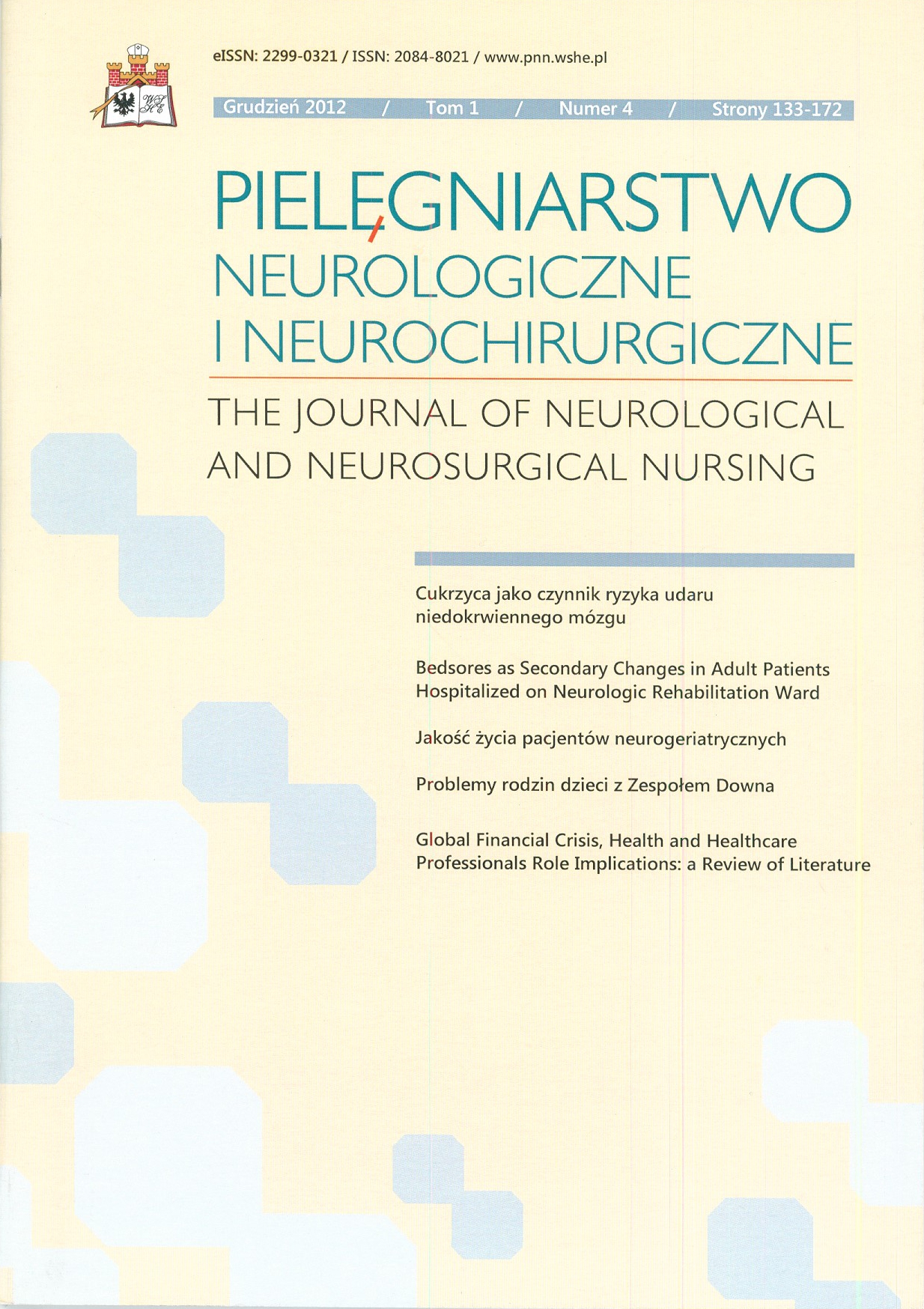Bedsores as Secondary Changes in Adult Patients Hospitalized on Neurologic Rehabilitation Ward
Keywords
neurorehabilitation, neurological deficit, bedsore, quality of lifeAbstract
Background. Prevalence of bedsores in neurological patients is rather known, although needs for further deeper research and continuous supervision. Bedsores can significantly influence both to rehabilitation effectivity, patients’ functional outcomes and quality of life.
Aim. Aim of this study was to assess and discuss occurence of bedsores in patients hospitalized on neurologic rehabilitation ward.
Materials and methods. The study was carried out among 36 adult patients hospitalized on neurological rehabilitation ward because of accidents resulting in neurological disorders. Patients were assessed using Torrance classification system and Norton Pressure Sore Risk-Assessment Scale Scoring System.
Results. Bedsores in patients with neurological deficits remain important problem despite increased consciousness both among medical staff, patients, and families/caregivers. Among 36 patiens involved in the study, decubitus ulcers were observed in 8.33%.
Conclusions. Bedsores are perceived as a significant issue influencing both efficiency of the therapy (including long-term rehabilitation), care, and quality of life of patients with neurological disorders. Larger research are necessary to further investigate both bedsores prevalence, and prevention strategies, especially in long-term rehabilitation and home care of patients with neurological deficits. (PNN 2012;1(4):144-150)
References
Gupta S., Ichioka S. Optimal use of negative pressure wound therapy in treating pressure ulcers. International Wound Journal. 2012;Aug9,Suppl1:8-16. doi: 10.1111/j.1742-481X.2012.01012.x.
Mikołajewska E. Incidence of bedsores in adult patients with neurological disorders. Journal of Health Sciences. 2012;2(2):51-59. EPUAP-NPUAP. Profilaktyka odleżyn. Retrieved 13.02.2012, from http://www.epuap.org/guidelines/ QRG_Prevention_in_Polish.pdf
Szewczyk M.T., Cwajda J., Cierzniakowska K. Zasady prowadzenia skutecznej profilaktyki ran odleżynowych. Wiadomości Lekarskie. 2006;59(11-12):842-847.
Brola W., Fudala M., Przybylski W., Czernicki J. Profilaktyka późnych powikłań udaru mózgu. Studia Medyczne. 2008;9:21-26.
Bell J. Are pressure ulcer grading & risk assessment tools useful? Wounds. 2005;1(2):62-69.
Norton D., McLaren R., Exton-Smith A.N. An investigation of geriatric nursing problems in hospital. Churchill Livingstone, London 1962.
Sae-Sia W., Wipke-Tevis D.D., Williams D.A. Elevated sacral skin temperature (T(s)): a risk factor for pressure ulcer development in hospitalized neurologically impaired Thai patients. Applied Nursing Research. 2005;18(1):29-35.
Malinowska K., Mikołajewska E. Odleżyny – wspólna płaszczyzna działań pielęgniarskich i rehabilitacyjnych u pacjenta leżącego. Pielęgniarstwo Chirurgiczne i Angiologiczne. 2009;2:60-64.
Mikołajewska E. Miejsce fizjoterapii w zapobieganiu i leczeniu ran odleżynowych. Praktyczna Fizjoterapia i Rehabilitacja. 2010;3:54-56.
Ingeman A., Andersen G., Hundborg H.H., Johnsen S.P. Medical complications in patients with stroke: data validity in a stroke registry and a hospital discharge registry. Clinical Epidemiology. 2010;2:5-13.
Kitisomprayoonkul W., Sungkapo P., Taveemanoon S., Chaiwanichsiri D. Medical complications during inpatient stroke rehabilitation in Thailand: a prospective study. Journal of the Medical Association of Thailand. 2010;93(5):594-600.
Sackley C., Brittle N., Patel S., et al. The prevalence of joint contractures, pressure sores, painful shoulder, other pain, falls, and depression in the year after a severely disabling stroke. Stroke. 2008;39(12):3329-3334.
Chen Y., DeVivo M.J., Jackson A.B. Pressure ulcer prevalence in people with spinal cord injury: age-period-duration effects. Archives of Physical Medicine and Rehabilitation. 2005;86(6):1208-1213.
Safaz I., Alaca R., Yasar E., Tok F., Yilmaz B. Medical complications, physical function and communication skills in patients with traumatic brain injury: a single centre 5 year experience. Brain Injury. 2008;22(10):733-739.
Zampolini M., Zaccaria B., Tolli V., Frustaci A., Franceschini M., GISCAR Group Rehabilitation of traumatic brain injury in Italy: a multi-centred study. Brain Injury. 2012;26(1):27-35.
Gélis A., Dupeyron A., Legros P., Benaďm C., Pelissier J., Fattal C. Pressure ulcer risk factors in persons with SCI: Part I: Acute and rehabilitation stages. Spinal
Cord. 2009;47(2):99-107.
Gélis A., Dupeyron A., Legros P., Benaďm C., Pelissier J., Fattal C. Pressure ulcer risk factors in persons with spinal cord injury part 2: the chronic stage. Spinal
Cord. 2009;47(9):651-661.
Salcido R., Popescu A., Ahn C. Animal models in pressure ulcer research. Journal of Spinal Cord Medicine. 2007;30(2):107-116.
Saladin L.K., Krause J.S. Pressure ulcer prevalence and barriers to treatment after spinal cord injury: comparisons of four groups based on race-ethnicity. NeuroRehabilitation. 2009;24(1):57-66.
Wilczewski P., Grimm D., Gianakis A., Gill B., Sarver W., McNett M. Risk factors associated with pressure ulcer development in critically ill traumatic spinal cord injury patients. Journal of Trauma Nursing. 2012;19(1):5-10.
Mikołajewska E. Wpływ rehabilitacji i fizjoterapii na poprawę jakości życia. Niepełnosprawność i Rehabilitacja. 2012;1:5-12.
Samuriwo R. Pressure ulcer prevention: the role of the multidisciplinary team. British Journal of Nursing. 2012;21(5):S4, S6, S8.
Flattau A., Blank A.E. Risk factors for 90-day and 180-day mortality in hospitalised patients with pressure ulcers. International Wound Journal. 2012 Jun 28. doi: 10.1111/j.1742-481X.2012.01032.x.
Justo D., Fridman V., Borodin O., Rozenberg F., Rabinovich A., Lerman Y. Admission Norton scale scores correlate with rehabilitation outcome and length in elderly patients following cerebrovascular accident. Aging Clinical and Experimental Research. 2011;23(5-6):445-449.
Ślusarz R., Śniegocka A., Śniegocki M. Czynniki wpływające na częstotliwość występowania problemów pielęgnacyjnych u chorych w stanie wegetatywnym przetrwałym. W: Rosińczuk-Tonderys J., Uchmanowicz I. (Red.), Chory przewlekle – aspekty pielęgnacyjne, rehabilitacyjne, terapeutyczne. MePharm, Wrocław 2011,403-413. Materiały z niepublikowanej pracy
magisterskiej autorstwa: Skibińska N. (promotor: Ślusarz R.).
Jabłońska R., Ślusarz R., Królikowska A. Subjective assessment of selected aspects of care quality in neurosurgical wards. Family Medicine & Primary Care Review. 2011;13(4):686-694.
Tang J.C., Vivas A., Rey A., Kirsner R.S., Romanelli P. Atypical ulcers: wound biopsy results from a university wound pathology service. Ostomy Wound Manage. 2012;58(6):20-29.
Downloads
Published
How to Cite
Issue
Section
License

This work is licensed under a Creative Commons Attribution-NoDerivatives 4.0 International License.
Stats
Number of views and downloads: 209
Number of citations: 0
